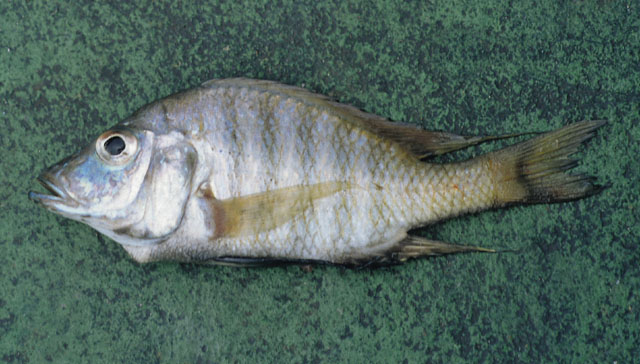| Cichlidae (Cichlids), subfamily: Pseudocrenilabrinae |
| 12.7 cm SL (male/unsexed) |
|
benthopelagic; freshwater; depth range 30 - 150 m |
| Africa: endemic to Lake Malawi. Found at Cape Maclear and Monkey Bay. |
|
Dorsal spines (total): 15-16; Dorsal soft rays (total): 9-11; Anal spines: 3-3; Anal soft rays: 8-9. Diagnosis: cleithrum elongated, forming a clear prominence protruding on the chest, already visible in specimens of 53.0mm SL; sensory pores on the head greatly enlarged (Ref. 55908).
Description: dentary rather shallow; outer oral jaw teeth in adults unicuspid, sometimes bicuspid in smaller specimens; inner row jaw teeth unicuspid; teeth moveably attached; lower pharyngeal bone slender with fine, acute teeth in low densities; 1 or 2 series of cheek scales; upper part of lateral line with 20-25 scales, lower part 12-18; gill-rakers long, simple, bi- or trifid; dorsal and anal fins of adult males with elongated filaments; pectoral fins relatively long (Ref. 55908).
Coloration: Live: Adult territorial males: background color green-blue to purple with black bars; body, and dorsal and posterior parts of head, with a brown-purple hue; green-blue component most pronounced on anterior and ventro-lateral parts of head; ventral parts black; dorsal and caudal fins grey-brown; dorsal fin margin black; dark maculae and striae pattern on dorsal and caudal fins; pectoral fins grey; anal fin black anteriorly and grey posteriorly with large white or yellow ocelli (Ref. 55908). Females: silvery with brownish hue on dorsal and dorso-lateral parts; fins grey; dorsal fin lappets dark brown; vague dark maculae and striae pattern on dorsal and caudal fins (Ref. 55908). Immature and non-territorial males intermediate between female and adult male gradually becoming darker and more bronzy and then green-blue with increasing territoriality (Ref. 55908). Preserved juveniles, females and non-territorial males: yellow-brown with 6 vertical bars under the dorsal fin base; bars sometimes barely visible; fins yellow-brown; dorsal fin with dark lappets and dark maculae; caudal fin without maculae; ventral, dorsal and distal parts of caudal fin somewhat darker than the rest (Ref. 55908). Small color pattern differences exist between populations (Ref. 55908). |
| Typical deep-water species, with an even distribution below 60m (Ref. 55908). Found in areas where the bottom consist of diatomaceous ooze (Ref. 5595) but also on sandy habitats (Ref. 55908). Food may consist of invertebrates (Ref. 5595) and perhaps small fishes (Ref. 55463). |
|
Least Concern (LC); Date assessed: 22 June 2018 Ref. (130435)
|
| harmless |
Source and more info: www.fishbase.org. For personal, classroom, and other internal use only. Not for publication.

